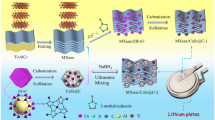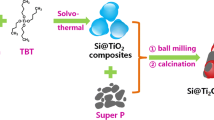Abstract
In order to investigate the synergistic effect of TiO2 and TiN on the electrochemical performance of SiO as anodes for lithium ion battery, a series of SiO/TiO2-TiN hybrid materials with different compositions are synthesized through simple high-energy mechanical ball milling using SiO, nano-TiO2 and nano-TiN as raw materials. Compared with TiO2 or TiN alone, the combination of TiO2 and TiN can significantly improve the utilization and cycle stability of SiO. Among them, the 65%SiO/35%(TiO2-TiN(8:2)) hybrid exhibits the best comprehensive electrochemical performance. Even at a relatively high mass loading and compaction density, the stable discharge capacity of the electrode is about 920 mAh g−1 at 100 mA g−1. At 500 mA g−1, the stable discharge capacity is kept at about 760 mAh g−1 until 250 cycles. When the current density increases to 1600 mA g−1, the stable capacity is still as high as 480 mAh g−1. The improved electrochemical performance is attributed to the synergistic effect of TiO2 and TiN in buffering the volume effect of Si and improving the conductivity of SiO. Different from the previous report, it is found that although the crystal structure of TiN is not destroyed during cycling, its initial reversible pseudocapacitance capacity reaches 80 mAh g−1 at 500 mA g−1.
Graphical abstract







Similar content being viewed by others
References
Bai Y, Yan D, Yu C, Cao L, Wang C, Zhang J, Zhu H, Hu Y, Dai S, Lu J, Zhang W (2016) Core-shell Si@TiO2 nanosphere anode by atomic layer deposition for Li-ion batteries. J Power Sources 308:75–82. https://doi.org/10.1016/j.jpowsour.2016.01.049
Bresser D, Oschmann B, Tahir MN, Mueller F, Lieberwirth I, Tremel W, Zentel R, Passerini S (2015) Carbon-coated anatase TiO2 nanotubes for li- and Na-Ion anodes. J Electrochem Soc 162:A3013–A3020. https://doi.org/10.1149/2.0031502jes
Chae S, Choi S, Kim N, Sung J, Cho J (2020) Integration of graphite and silicon anodes for the commercialization of high-energy lithium-ion batteries. Angew Chem Int Edit 59:110–135. https://doi.org/10.1002/anie.201902085
Dou F, Shi L, Song P, Chen G, An J, Liu H, Zhang D (2018) Design of orderly carbon coatings for SiO anodes promoted by TiO2 toward high performance lithium-ion battery. Chem Eng J 338:488–495. https://doi.org/10.1016/j.cej.2018.01.048
Dou F, Weng Y, Chen G, Shi L, Liu H, Zhang D (2020) Volume expansion restriction effects of thick TiO2/C hybrid coatings on micro-sized SiOx anode materials. Chem Eng J 387:124106. https://doi.org/10.1016/j.cej.2020.124106
Fang R, Miao C, Mou H, Xiao W (2020) Facile synthesis of Si@TiO2@rGO composite with sandwich-like nanostructure as superior performance anodes for lithium ion batteries. J Alloy Compd 818:152884. https://doi.org/10.1016/j.jallcom.2019.152884
Guo L, He H, Ren Y, Wang C, Li M (2018) Core-shell SiO@F-doped C composites with interspaces and voids as anodes for high-performance lithium-ion batteries. Chem Eng J 335:32–40. https://doi.org/10.1016/j.cej.2017.10.145
Han J, Chen G, Yan T, Liu H, Shi L, An Z, Zhang J, Zhang D (2018) Creating graphene-like carbon layers on SiO anodes via a layer-by-layer strategy for lithium-ion battery. Chem Eng J 347:273–279. https://doi.org/10.1016/j.cej.2018.04.100
Huang X, Li M (2018) Multi-channel and porous SiO@N-doped C rods as anodes for high-performance lithium-ion batteries. Appl Surf Sci 439:336–342. https://doi.org/10.1016/j.apsusc.2017.12.184
Li G, Li J, Yue F, Xu Q, Zuo T, Yin Y, Guo Y (2019) Reducing the volume deformation of high capacity SiOx/G/C anode toward industrial application in high energy density lithium-ion batteries. Nano Energy 60:485–492. https://doi.org/10.1016/j.nanoen.2019.03.077
Li H, Huang X, Chen L (1999) Electrochemical impedance spectroscopy study of SnO and nano-SnO anodes in lithium rechargeable batteries. J Power Sour 81:340–345. https://doi.org/10.1016/S0378-7753(99)00214-1
Liu L, Li X, He G, Zhang G, Su G, Fang C (2020) SiO@C/TiO2 nanospheres with dual stabilized architecture as anode material for high-performance Li-ion battery. J Alloy Compd 836:155407. https://doi.org/10.1016/j.jallcom.2020.155407
Liu Q, Pang C, Chen W, Rao Z, Lu H, Xue L, Zhang W (2019) Double coating of micron-sized silicon by TiN@NC for high-performance anode in lithium-ion batteries. Energy Technol-Ger 7:1900487. https://doi.org/10.1002/ente.201900487
Liu R, Lun N, Qi Y, Bai Y, Zhu H, Han F, Meng X, Bi J, Fan R (2011) Microwave absorption properties of TiN nanoparticles. J Alloy Compd 509:10032–10035. https://doi.org/10.1016/j.jallcom.2011.08.022
Maurya IC, Singh S, Senapati S, Srivastava P, Bahadur L (2019) Green synthesis of TiO2 nanoparticles using Bixa orellana seed extract and its application for solar cells. Sol Energy 194:952–958. https://doi.org/10.1016/j.solener.2019.10.090
Pan K, Zou F, Canova M, Zhu Y, Kim J (2019) Systematic electrochemical characterizations of Si and SiO anodes for high-capacity Li-Ion batteries. J Power Sources 413:20–28. https://doi.org/10.1016/j.jpowsour.2018.12.010
Shi L, Pang C, Chen S, Wang M, Wang K, Tan Z, Gao P, Ren J, Huang Y, Peng H, Liu Z (2017) Vertical graphene growth on SiO microparticles for stable lithium ion battery anodes. Nano Lett 17:3681–3687. https://doi.org/10.1021/acs.nanolett.7b00906
Tang D, Yi R, Gordin ML, Melnyk M, Dai F, Chen S, Song J, Wang D (2014) Titanium nitride coating to enhance the performance of silicon nanoparticles as a lithium-ion battery anode. J Mater Chem A. https://doi.org/10.1039/C4TA01343C
Veluchamy A, Doh C, Kim D, Lee J, Lee D, Ha K, Shin H, Jin B, Kim H, Moon S, Park C (2009) Improvement of cycle behaviour of SiO/C anode composite by thermochemically generated Li4SiO4 inert phase for lithium batteries. J Power Sources 188:574–577. https://doi.org/10.1016/j.jpowsour.2008.11.137
Wang M, Yin L, Li M, Luo S, Wang C (2019) Low-cost heterogeneous dual-carbon shells coated silicon monoxide porous composites as anodes for high-performance lithium-ion batteries. J Colloid Interf Sci 549:225–235. https://doi.org/10.1016/j.jcis.2019.04.076
Wu W, Liang Y, Ma H, Peng Y, Yang H (2016) Insights into the conversion behavior of SiO-C hybrid with pre-treated graphite as anodes for Li-ion batteries. Electrochim Acta 187:473–479. https://doi.org/10.1016/j.electacta.2015.11.008
Xiang J, Liu H, Na R, Wang D, Shan Z, Tian J (2020) Facile preparation of void-buffered Si@TiO2/C microspheres for high-capacity lithium ion battery anodes. Electrochim Acta 337:135841. https://doi.org/10.1016/j.electacta.2020.135841
Yamamura H, Nakanishi S, Iba H (2013) Reduction effect of irreversible capacity on SiO anode material heat-reacted with Fe2O3. J Power Sources 232:264–269. https://doi.org/10.1016/j.jpowsour.2013.01.038
Yang J, Wang Y, Li W, Wang L, Fan Y, Jiang W, Luo W, Wang Y, Kong B, Selomulya C, Liu HK, Dou SX, Zhao D (2017) Amorphous TiO2 shells: a vital elastic buffering layer on silicon nanoparticles for high-performance and safe lithium storage. Adv Mater 29:1700523. https://doi.org/10.1002/adma.201700523
Yi Z, Lin N, Xu T, Qian Y (2018) TiO2 coated Si/C interconnected microsphere with stable framework and interface for high-rate lithium storage. Chem Eng J 347:214–222. https://doi.org/10.1016/j.cej.2018.04.101
Zhang J, Zhang J, Bao T, Xie X, Xia B (2017) Electrochemical and stress characteristics of SiO/Cu/expanded graphite composite as anodes for lithium ion batteries. J Power Sources 348:16–20. https://doi.org/10.1016/j.jpowsour.2017.02.076
Zhang P, Gao Y, Ru Q, Yan H, Chen F, Ling FC (2019) Scalable preparation of porous nano-silicon/TiN@carbon anode for lithium-ion batteries. Appl Surf Sci 498:143829. https://doi.org/10.1016/j.apsusc.2019.143829
Zhang Y, Guo G, Chen C, Jiao Y, Li T, Chen X, Yang Y, Yang D, Dong A (2019) An affordable manufacturing method to boost the initial Coulombic efficiency of disproportionated SiO lithium-ion battery anodes. J Power Sources 426:116–123. https://doi.org/10.1016/j.jpowsour.2019.04.032
Zhou M, Gordin ML, Chen S, Xu T, Song J, Lv D, Wang D (2013) Enhanced performance of SiO/Fe2O3 composite as an anode for rechargeable Li-ion batteries. Electrochem Commun 28:79–82. https://doi.org/10.1016/j.elecom.2012.12.013
Zhou N, Wu Y, Zhou Q, Li Y, Liu S, Zhang H, Zhou Z, Xia M (2019) Enhanced cycling performance and rate capacity of SiO anode material by compositing with monoclinic TiO2 (B). Appl Surf Sci 486:292–302. https://doi.org/10.1016/j.apsusc.2019.05.025
Zhou T, Lv W, Li J, Zhou G, Zhao Y, Fan S, Liu B, Li B, Kang F, Yang Q (2017) Twinborn TiO2-TiN heterostructures enabling smooth trapping-diffusion-conversion of polysulfides towards ultralong life lithium-sulfur batteries. Energ Environ Sci 10:1694–1703. https://doi.org/10.1039/C7EE01430A
Zhu G, Zhang F, Li X, Luo W, Li L, Zhang H, Wang L, Wang Y, Jiang W, Liu HK, Dou SX, Yang J (2019) Engineering the distribution of carbon in silicon oxide nanospheres at the atomic level for highly stable anodes. Angew Chem Int Edit 58:6669–6673. https://doi.org/10.1002/anie.201902083
Acknowledgement
This research was financially supported by National Undergraduate Training Program for Innovation and Entrepreneurship (No. 201910638005), Sichuan Science and Technology Program (No. 21YYJC1247), Education Department Foundation of Sichuan Province (No. 17TD0036) and Natural Science Foundation of China (No. 51374175).
Author information
Authors and Affiliations
Corresponding author
Ethics declarations
Conflict of interest
There is no conflict of interest.
Additional information
Handling Editor: Mark Bissett.
Publisher's Note
Springer Nature remains neutral with regard to jurisdictional claims in published maps and institutional affiliations.
Rights and permissions
About this article
Cite this article
Liu, L., Zhong, X. & Li, M. Synergistic effect of TiO2 and TiN on the electrochemical performance of SiO as anodes for lithium ion battery. J Mater Sci 56, 7587–7597 (2021). https://doi.org/10.1007/s10853-020-05750-9
Received:
Accepted:
Published:
Issue Date:
DOI: https://doi.org/10.1007/s10853-020-05750-9




